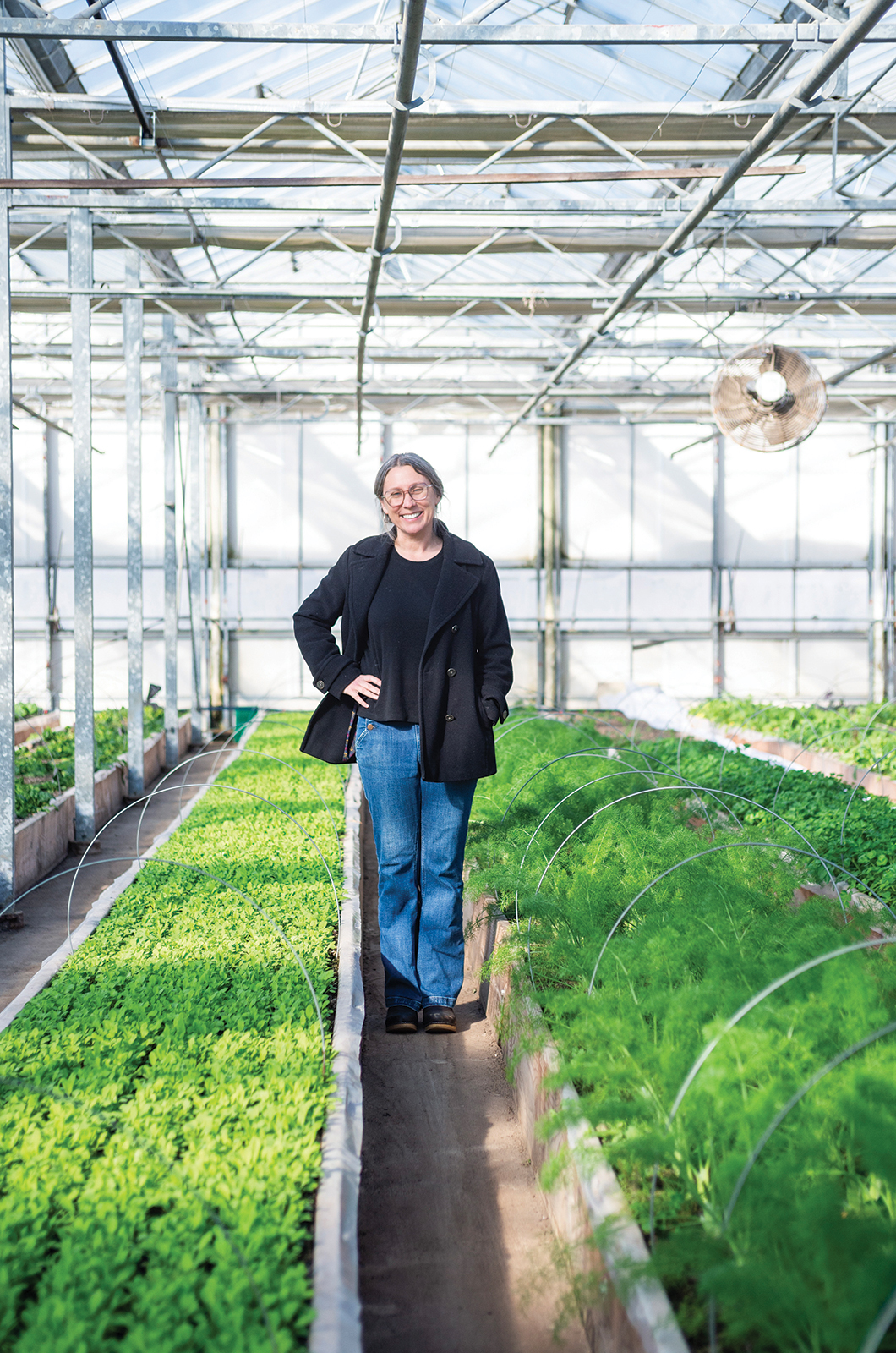Noli Taylor has been a major contributor to food sustainability, food equity and food education on Martha’s Vineyard for almost 20 years. She began working with Island Grown Initiative (IGI) when it was first coalescing in 2006. Through the years, she has been instrumental in helping the nonprofit organization to develop into a well-respected model of community-focused programming in the Northeast. By integrating agriculture, education and food access, IGI has set an example of how food systems can benefit an entire community and inspire a new generation to understand and engage with where their food comes from.
Now, as executive director of IGI, Noli continues to work to make Martha’s Vineyard a healthier, more connected and vibrant community, while overseeing a diverse collection of initiatives to improve food security and sustainable farming on the Island.
Q. What was your journey to the Island? What brought you here?
A . I was living on the north shore of Kauai, Hi. Incredible place. I was doing community organizing work around agriculture and food systems, but also guiding hikes and working at a coffee shop, like people in their early twenties do. Isaac Taylor was out there on a surf trip and came into the coffee shop. And that’s how we first met.
Q. How serendipitous – a surfer walks into the coffee shop!
A. I didn’t know much about Martha’s Vineyard, but Isaac, born and raised here, was part of 17 generations on his mom’s side. (Isaac’s parents are Hugh and Jeanne Taylor, owners of the Outermost Inn.) Eventually I ended up coming out here to be with Isaac. We got married and we had our two kids. And since then, my parents sold their house in Oregon and Isaac built them an apartment, and they live with us now in Aquinnah. Multi-generational living! And I never thought I would settle on the East Coast. It was a real surprise. But now I’ve lived on islands since I was 21.
Q. How did your experience in Hawaii lead to what you have worked on here?
A. There is a lot of pressure in Hawaii around corporate control of land. I was working with incredible farmers and native Hawaiians who were creating a more sustainable local food system. I was part of this movement of resistance to some of that genetic engineering and chemical agriculture. And we were trying to support local seed systems and protect important native crops like taro. I loved the work I was doing in Hawaii.
Q. What first struck you about the Vineyard and the opportunities to continue that work?
A. When I came here in 2005 to visit Isaac, it just blew my top off because there is no corporate presence on this Island. There was so much valuing of local farms and farmers, and there was also this real sense of historic preservation around the agricultural heritage. It was so exciting to think about what was possible to do in a place like this.
Q. What was the state of IGI when you first got involved?
A. We were an excited group of volunteers, led by Ali Berlow, starting to coalesce around important ideas – especially working with children. We began working with the support of a Martha’s Vineyard Vision Fellowship.
Q. What are the fruits of the 18-year-old Island Grown School curriculum today?
A. Now from the time you are two years old, you go to school in the fall, and there’s your school garden that has beautiful food growing in it, and you have a garden teacher who teaches you how to grow plants, how to protect soil, how to save seeds, and in the winter, how to prepare nutritious food with what’s available seasonally. We take kids on field trips to get to know farmers and to understand farming as a profession, and that continues through high school. Astrid Tilton, our gleaning manager, started as part of Island Grown Schools as a young child!
Q. How have your own children benefited from the programs?
A. My son, Emmett, 15, has done our summer internship working on farms and in the pantry. My daughter, Tilly, in sixth grade, has been part of Island Grown Schools since she was two. Both were with me when the governor signed the farm-to-school bill that local kids helped push through to support farm-to-school education across the state.
Q. IGI also serves Island seniors. I stopped in on Senior Day last Friday at the new location of the Island Food Pantry in Oak Bluffs. It’s so welcoming, organized and copious.
A. If you’re a senior on a fixed income, it’s getting more and more challenging to live on the Island. While most of our clients do online ordering and pickup, seniors can shop in person on Fridays. It’s an incredible array of foods. Most of what we’re growing now at the Island Grown Farm, we donate through the pantry, to pantry clients. So there’s beautiful, fresh local produce and we get about 10,000 pounds of [other] food every week, most of it from the Greater Boston Food Bank. And that’s an array of dry goods, shelf-stable goods, dairy and proteins.
Q. Prepared meals are also a big part of the IGI mission.
A. Yes, at [our commercial kitchen at] the Airport Business Park, we make about 75,000 prepared meals a year for donation. The need for prepared foods was actually something that emerged out of a regular meeting of the Vineyard Food Equity Network – a group of 25 different Island organizations that work on food access programs in one way or another. Schools, churches, the Martha’s Vineyard Boys & Girls Club, the Martha’s Vineyard Hospital and councils on aging come together to support each other.
Q. Tell me about IGI’s productive gleaning program and its work in sustainable farming.
A. The concept of gleaning first emerged from a biblical practice in which farmers opened their fields to the poor to collect what was left after the main harvest. There’s always some level of waste that is baked into farming. If you’ve planted one row of zucchini and then a few weeks later planted another row, that second row starts producing zucchini when the first row still has some. So, you switch over to harvest zucchini from the newer plants, but the first row of plants still has some left that you leave behind to be gleaned. Gleaning is a fantastic way to volunteer with us. It’s so fun and it’s so rewarding.
Q. Do you know how much you harvest per year?
A . I think they harvested 63,000 pounds of food last year. And that has been a real game-changer in terms of food access in our community. In 15 years, we’ve harvested over 500,000 pounds of food, most of which would not have otherwise been harvested.
Q. How has the face of food insecurity changed on the Island?
A. Well, the need has grown dramatically in the past five years. More than twice as many people are coming to the food pantry for support now than were coming in 2019, and those numbers are not going down. The cost of living on the Island has made it so that more and more people in our community just can’t afford to make ends meet. And the face of that is just a huge diversity of people. And the lack of affordable housing is a huge driver for food support.
Q. How are you addressing climate change in your work?
A. We led the creation of the food security component of the Martha’s Vineyard Commission’s Climate Action Plan. We defined specific objectives and actions; one is to increase local and regional food consumption on the Island so that by 2040 50 percent of the food that we consume on the Vineyard would come from local and regional sources. We define the region as New England plus New York and include food from the waters — from the ponds and from the ocean. We have incredible partners in the shellfishing world and in the fishing community.
Q. What other initiatives are on your plate?
A. The other piece I’m really excited about is the idea that food is medicine. That’s an orientation the health care sector is moving toward. The hospital gave us a grant, so we’ll be able to provide CSA shares — our community-supported agriculture program through the farm — to patients who are referred to us because they’re facing food insecurity or diet-related disease.
Q. How does IGI make these many initiatives a reality?
A. We’re just coming out of such a huge time of growth for our organization. We recently completed the building of employee housing at our farm, and we just bought and remodeled a permanent location for the Island Food Pantry. So, then we began thinking, “ Okay, now where are we going next? ”
Q. IGI is connected to the Island in so many ways!
A. That’s the thing about food. It’s at the heart of all of our lives. Every day we’re interacting with food, over and over. It really ties everything together and it’s how we connect to each other.
Sissy Biggers lives in Oak Bluffs and is the Q&A columnist for The Vine.




 4 comments
4 comments






Comments (4)
Comments